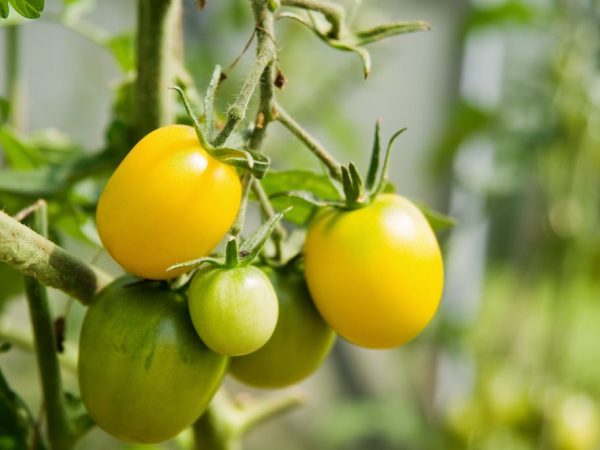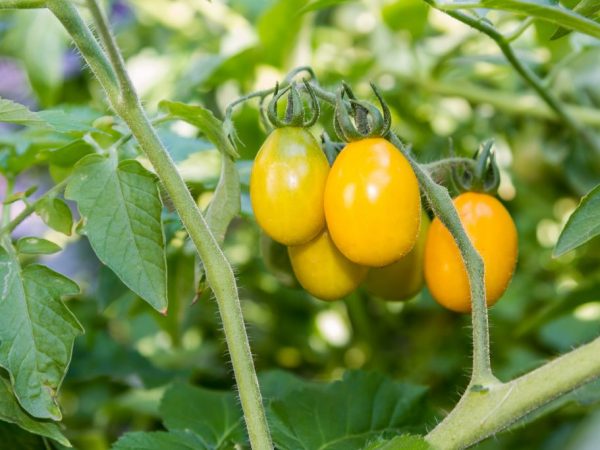Description of tomato Golden eggs
Like other fruit crops, tomatoes have many varieties that differ in appearance, taste and difficulty in growing. Consider what the Golden Eggs tomato is.

Description of tomato Golden eggs
Description of the variety
Being a dwarf (determinant) non-standard plant, Golden Eggs ripen quickly. Unlike indeterminate ones, this species cannot grow indefinitely and stops at 4-6 brushes. The flower cluster begins to form after 5-6 leaves, then every 2 inflorescences. In the south and in the middle zone, tomatoes Golden eggs can be grown outdoors. If a greenhouse is chosen as a place for seedlings, the stems grow vigorously, therefore, it is necessary to tie up the branches of the plant.
What are the main characteristics of the variety of tomatoes Golden Eggs:
- the height of the bushes is from 30 to 40 cm;
- medium leaf size, simple inflorescence;
- elongated ovoid shape, which gave the name to the variety, compactness;
- bright orange or yellow fruits weighing 100-200 g;
- thin but durable glossy skin;
- fleshy pulp with an exquisite sweet and sour taste and a high dry matter content;
- 6-12 nests in the fetus;
- high yield (10-15 fruits per bush, i.e. about 1.5 kg) and early germination (about 120 days before the beginning of fruiting).
Positive traits
Golden eggs are suitable for planting and growing almost all over the country, as they are oriented to the conditions of a changeable climate. One of the main advantages of the variety is the simultaneous ripening of the fruit.
The variety, bred by Siberian breeders, is famous for its unpretentiousness, resistance to cold weather and strong immunity to fungal diseases. He tolerates the absence of sunlight perfectly. It is checked for quality twice: in the company's own laboratory and in the State Seed Inspection.
Siberian seeds, including Golden Eggs, are also popular abroad, where they are valued for their yield. They tolerate transportation well, do not crack, thanks to the strong skin. According to the description, the fruits are stored in a closed container for about two months.
Growing
The plant is grown both in a greenhouse and in the open field, depending on the climatic conditions of the area. The yield of tomatoes in the greenhouse is higher.
Before planting in the ground, the seedlings are hardened without watering, subjecting to increased ventilation and leaving overnight on the street or by an open window 5 days before planting. This event is necessary so that the seedlings calmly react to temperature changes and increase immunity to diseases. Pre-treated seeds are planted in closed soil in mid-March to a depth of at least 1 cm. m recommend planting 6 plants.
Seedlings are planted in open ground at the end of May. Weakly acidic soil is prepared for planting by moistening the top layer. The wells are filled with a small amount of superphosphate. At the same time, a distance of 0.5 m between the bushes and 25-40 cm between the rows is maintained. Plants form 3 stems.No garter or pinning is required. The moisture level around the seed plot should not be higher than the permissible norm. The crop is usually harvested in August.
Growing in unfavorable conditions

The hardening process will increase the yield
Golden eggs still need enough warmth and light. To provide an artificial stimulator, it is necessary to use agricultural techniques. One of the main ones consists in the pre-sowing preparation of not only seedlings, but also seeds: during hardening, the growth process and its synchronization are accelerated. This increases the yield of the entire run.
The swollen seed is placed in a refrigerator for ¾ days, the temperature there should be 0 ° C. The remaining 6 hours are kept in the room. The hardening procedure is repeated for at least 8 days. In March, dried seeds are treated with peat, planted in pots and covered with foil. The containers should stand in a room with room temperature.
In less than a week, the first shoots will appear, after which the film is removed, and the seedlings are placed in a bright room with a temperature of 15 ° C. After a week, the temperature is increased, and after the appearance of the first leaves, the seedlings are divided into different containers.
7 days before planting, the seedlings are fed with a mixture of phosphorus and potassium. Better if it happens in sunny weather. After feeding, the seedlings are watered with water at room temperature and the room is ventilated.
Tomato care
Since plants are quite capable of germinating 60-90 cm up in a greenhouse, their stems need a garter. Further care consists in ensuring regular watering, weeding and fertilizing the earth with fertilizers. As a top dressing for the variety, superphosphate, aged manure, nitrophoska, potassium sulfate are used.
Seedlings are watered every evening with water at room temperature, fertilizers are applied to the soil and the soil is loosened. Such rather banal events will ultimately allow you to get a gorgeous harvest.
Pests and fungal diseases
Tomato Golden eggs has a stable immunity to various kinds of diseases, and tobacco mosaic and brown spot - one of the most common viruses among plants - are not at all afraid of it. But there are fungi that can infect a plant:
- Gray rot is treated with a fungicide and triazole.
- Late blight is also defeated with fungicides and using ordinary table salt.
- Fusarium and Alternaria are treated with similar means.
As for harmful insects, the main danger for tomatoes is the bear, whitefly, aphid, and nematode. A large assortment of insecticides is available on the modern market to combat these parasites. From folk remedies, preference is given to garlic tincture: 0.5 kg of chopped garlic is added to 1 liter of water. The solution should be infused for a day, after which the plant is sprayed with it.
Summarizing
Tomato variety Golden Eggs deservedly occupies a leading position among the tomatoes grown on farms. Relative unpretentiousness and productivity are his trump cards.


